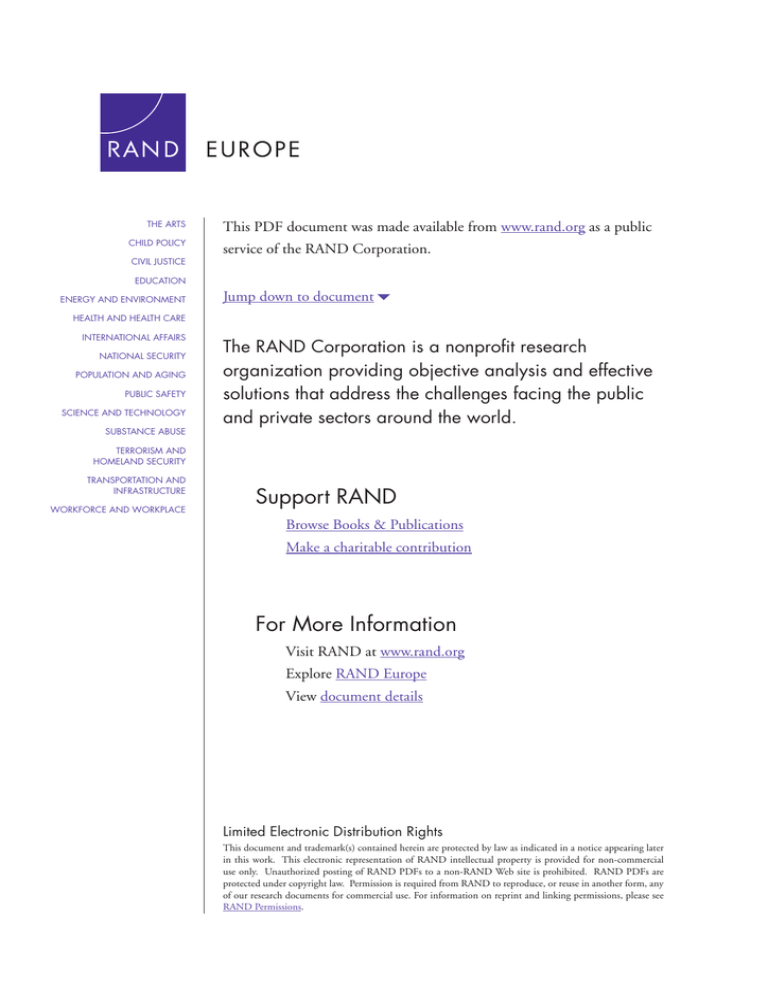
THE ARTS
CHILD POLICY
CIVIL JUSTICE
This PDF document was made available from www.rand.org as a public
service of the RAND Corporation.
EDUCATION
ENERGY AND ENVIRONMENT
Jump down to document6
HEALTH AND HEALTH CARE
INTERNATIONAL AFFAIRS
NATIONAL SECURITY
POPULATION AND AGING
PUBLIC SAFETY
SCIENCE AND TECHNOLOGY
SUBSTANCE ABUSE
The RAND Corporation is a nonprofit research
organization providing objective analysis and effective
solutions that address the challenges facing the public
and private sectors around the world.
TERRORISM AND
HOMELAND SECURITY
TRANSPORTATION AND
INFRASTRUCTURE
WORKFORCE AND WORKPLACE
Support RAND
Browse Books & Publications
Make a charitable contribution
For More Information
Visit RAND at www.rand.org
Explore RAND Europe
View document details
Limited Electronic Distribution Rights
This document and trademark(s) contained herein are protected by law as indicated in a notice appearing later
in this work. This electronic representation of RAND intellectual property is provided for non-commercial
use only. Unauthorized posting of RAND PDFs to a non-RAND Web site is prohibited. RAND PDFs are
protected under copyright law. Permission is required from RAND to reproduce, or reuse in another form, any
of our research documents for commercial use. For information on reprint and linking permissions, please see
RAND Permissions.
This product is part of the RAND Corporation documented briefing series. RAND
documented briefings are based on research briefed to a client, sponsor, or targeted audience and provide additional information on a specific topic. Although documented
briefings have been peer reviewed, they are not expected to be comprehensive and may
present preliminary findings.
Health and Medical
Research in the United
States
Observatory on Health Research
Systems
Miriam Shergold
The research described in this report was prepared as part
of RAND Europe's Health Research System Observatory
Documented Briefing series, funded by the English Department
of Health.
The research described in this report was prepared as part of RAND Europe's Health
Research System Observatory Documented Briefing series, funded by the English
Department of Health.
The RAND Corporation is a nonprofit research organization providing objective analysis
and effective solutions that address the challenges facing the public and private sectors
around the world. RAND’s publications do not necessarily reflect the opinions of its
research clients and sponsors.
R® is a registered trademark.
© Copyright 2008 RAND Corporation
All rights reserved. No part of this book may be reproduced in any form by any electronic or
mechanical means (including photocopying, recording, or information storage and retrieval)
without permission in writing from RAND.
Published 2008 by the RAND Corporation
1776 Main Street, P.O. Box 2138, Santa Monica, CA 90407-2138
1200 South Hayes Street, Arlington, VA 22202-5050
4570 Fifth Avenue, Suite 600, Pittsburgh, PA 15213-2612
Westbrook Centre, Milton Road, Cambridge CB4 1YG, United Kingdom
RAND URL: http://www.rand.org
RAND Europe URL: http://www.rand.org/randeurope
To order RAND documents or to obtain additional information, contact
Distribution Services: Telephone: (310) 451-7002;
Fax: (310) 451-6915; Email: order@rand.org
Summary
Summary: Key Points
• The United States holds a premier position in funding and conducting
health R&D
• Key players among funders are industry and the NIH
• Industry and NIH strive to optimise investments through governance
arrangements and funding policies that reflect the respective priorities
of profitability and public health improvements
• Following a surge in funding at the turn of the millennium, recent
years have seen budgets stagnate
• Funding shortages, ethical restrictions, and immigration hurdles
threaten the United States’ traditional ability to attract, develop, and
retain world-class research capacity
The United States is the world leader in health research in terms of total investment, as
well as investment in proportion to overall health spending. In the decade leading up to
2003, investment almost doubled to $94.3 billion (0.86% of GDP2), representing 5.6
percent of total health spending. The country hosts a range of world-class public and nonprofit research institutions that attract international talent and recognition. At the same
time, it is a hub for industrial R&D in pharmacology, biotechnology, and medical devices:
in 2003, 70 percent of the global drug development pipeline belonged to companies
headquartered in the United States. Health R&D has traditionally benefited from support
from both leading political parties.
Due to the scale of R&D activities in the United States, even funders that compare to large
investors in other research intensive countries are dwarfed by the system’s principal players:
industry and the publicly funded National Institutes of Health (NIH). Together, these key
players provide over 80 percent of all support of health research in the country.
The large budgets handled by businesses and the NIH pose a significant strategic challenge
to the organisations’ leaders. This is addressed by governance structures that reflect the
respective aims of generating profits for shareholders and supporting research excellence in
the service of public health. Both private and public funders have formulated strategic
2
Percentage of gross domestic product (GDP) statistics are calculated using OECD Statistics: GDP, Annual in
millions Current Prices (National Currency). http:stats.oecd.org
vii
The Health Research System of the United States
RAND Europe
priorities to guide their funding policy. This is exemplified by the NIH Roadmap for
Medical Research, which identifies key prerequisites for effective future investigation, and
companies’ decisions to focus on specific therapeutic areas or rates of return.
Following a period of rapid growth up to 2003, during which the NIH budget doubled,
funding levels have stagnated, a trend also noticeable in for-profit investment. Influenced
by competing public demands, such as public resources needed for disaster relief, this
development has led to grave concerns among researchers. In particular, it has become
increasingly difficult for young researchers to obtain support. Research advocacy
representatives also argue that diminished investment will result in higher health costs in
the future.
There is concern that young researchers’ difficulties in obtaining support to develop their
career and investigations will undermine recent years’ successes in fostering a new
generation of promising scientists. Researchers also warn that more cumbersome
immigration procedures and ethically motivated restrictions on research, for example on
research with stem cells, are affecting the United States’ traditional status as a researcher
magnet.
viii





